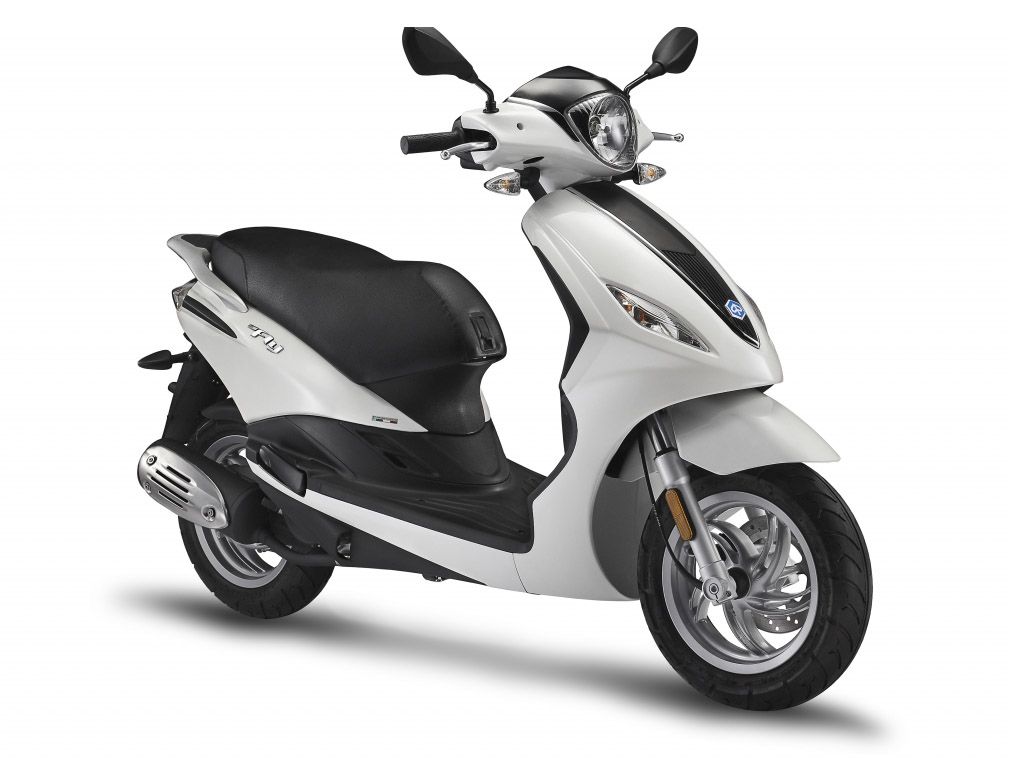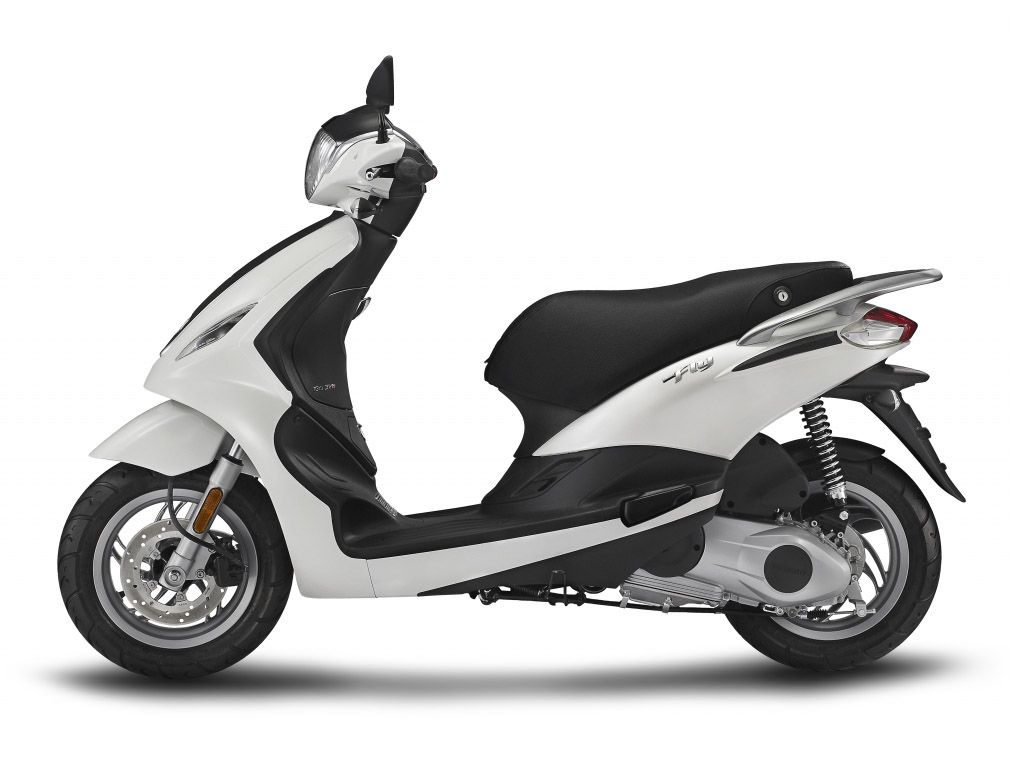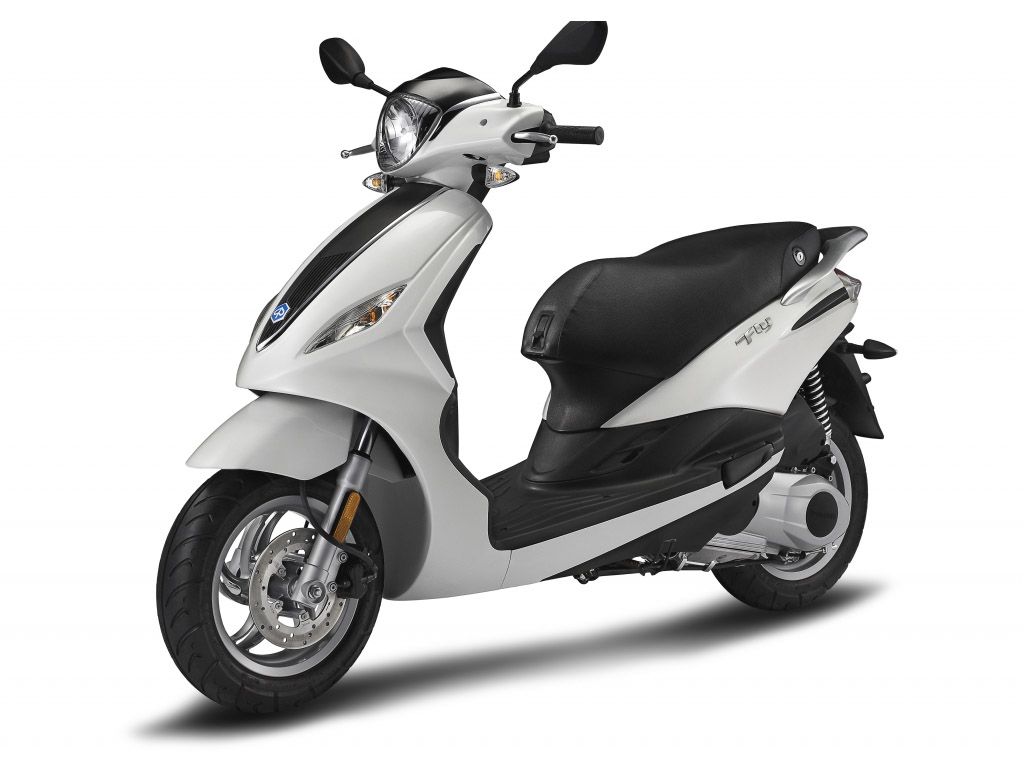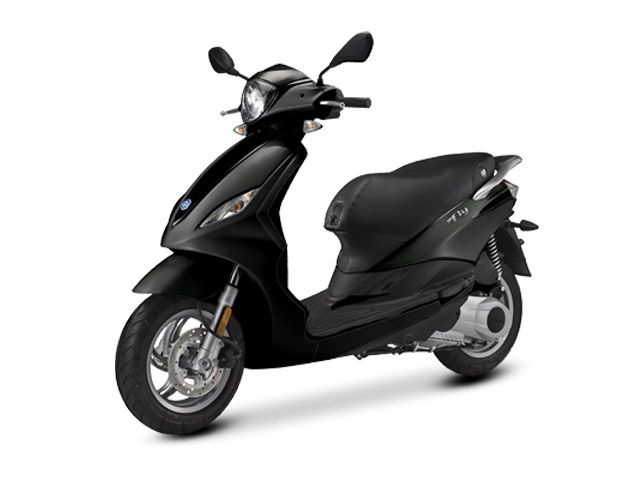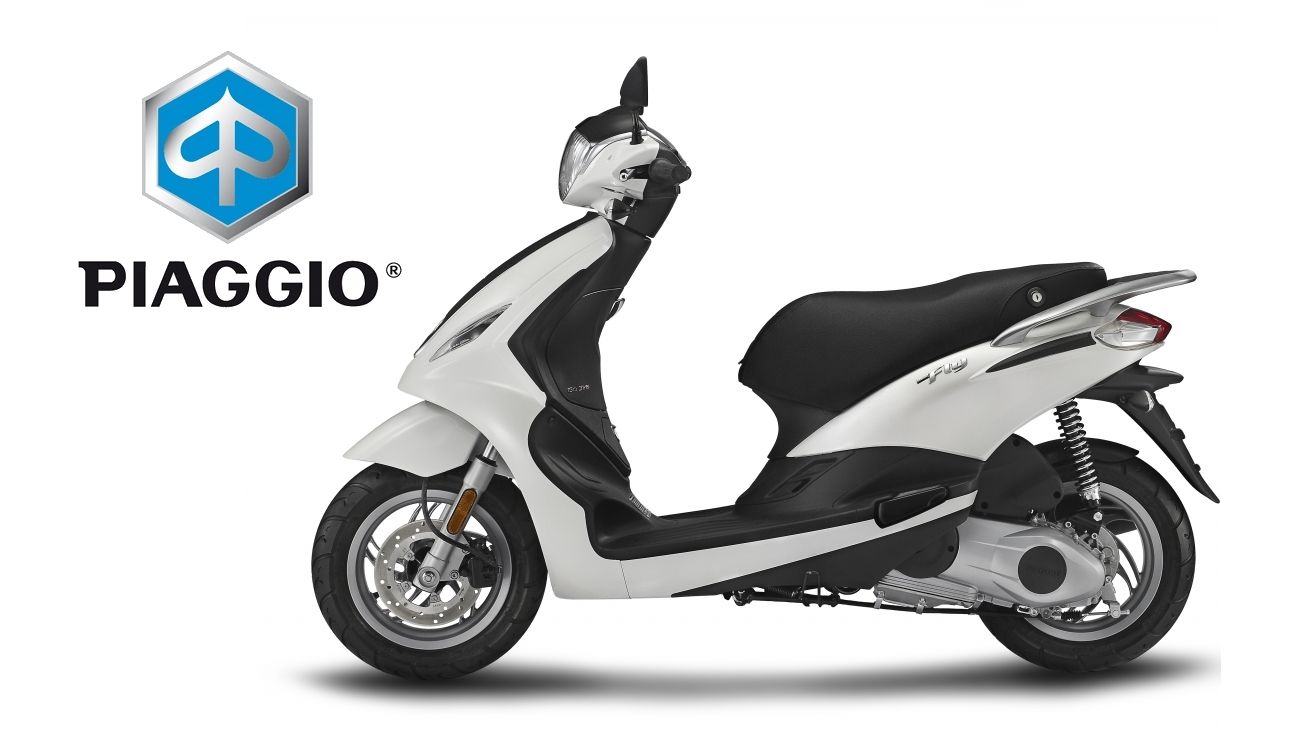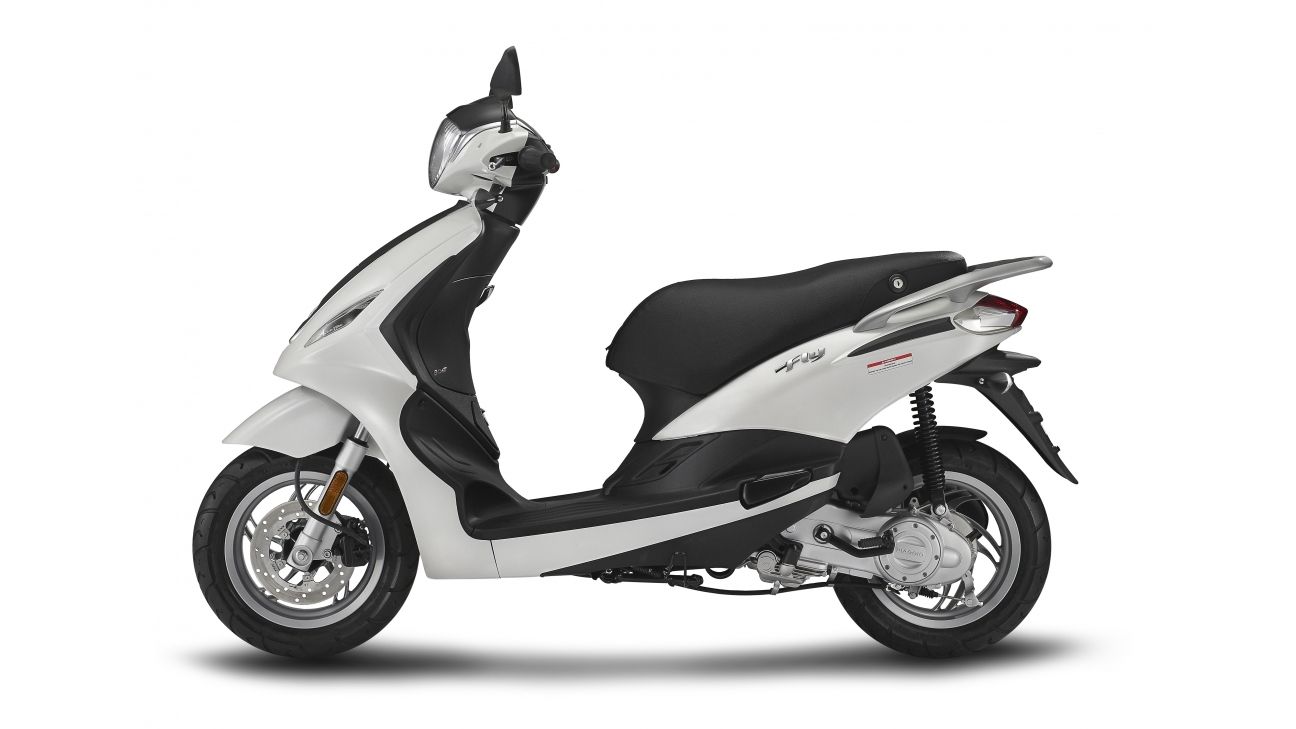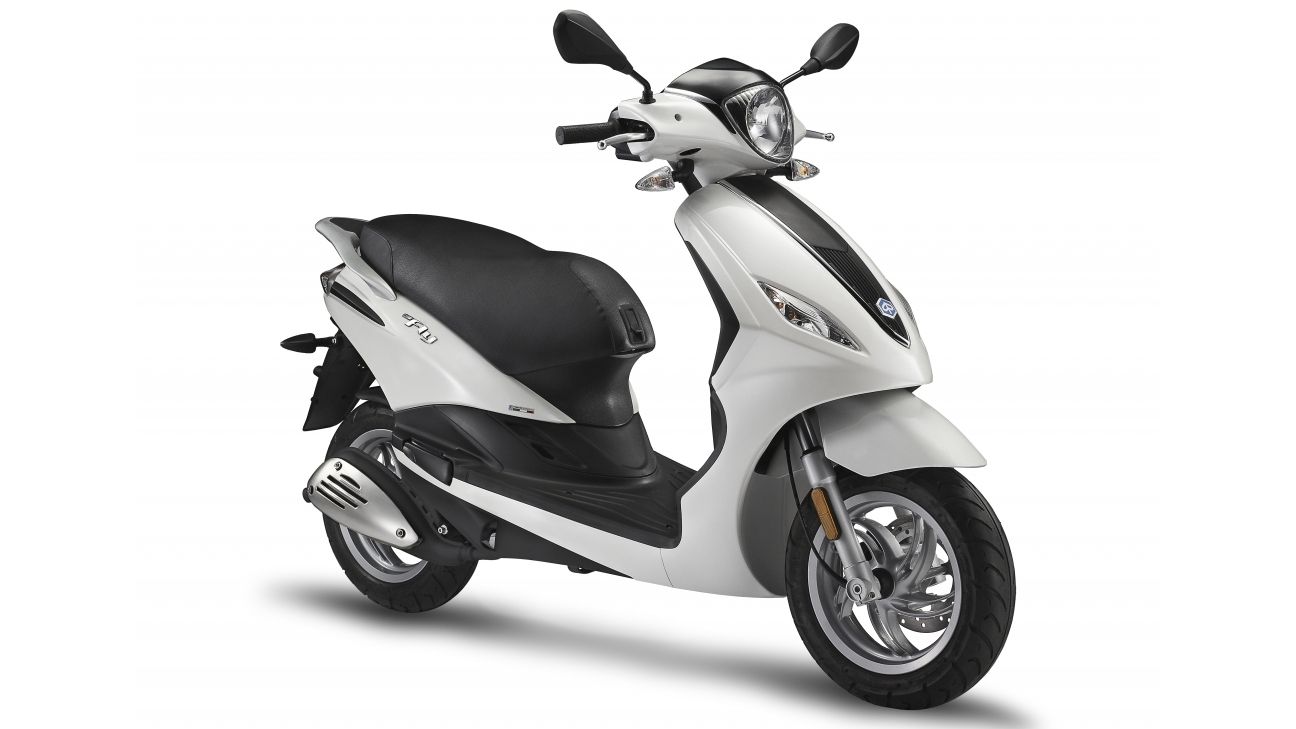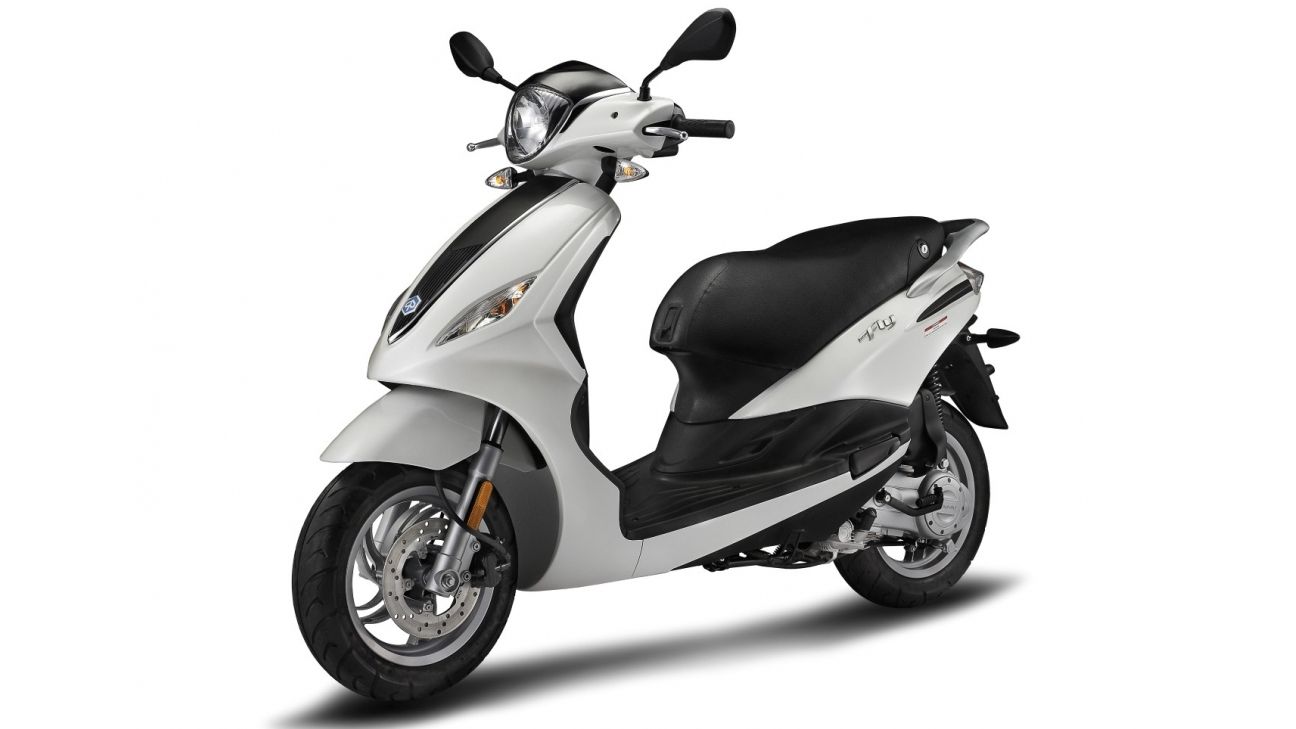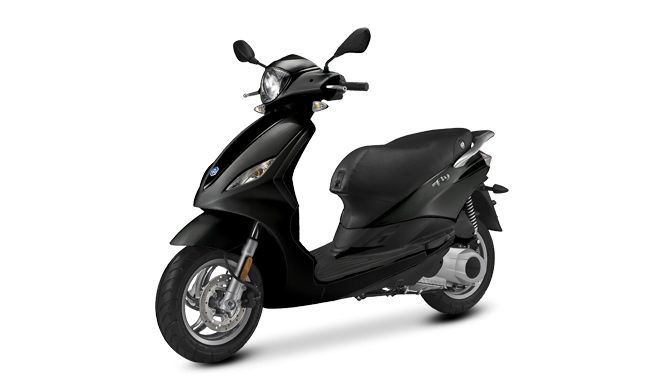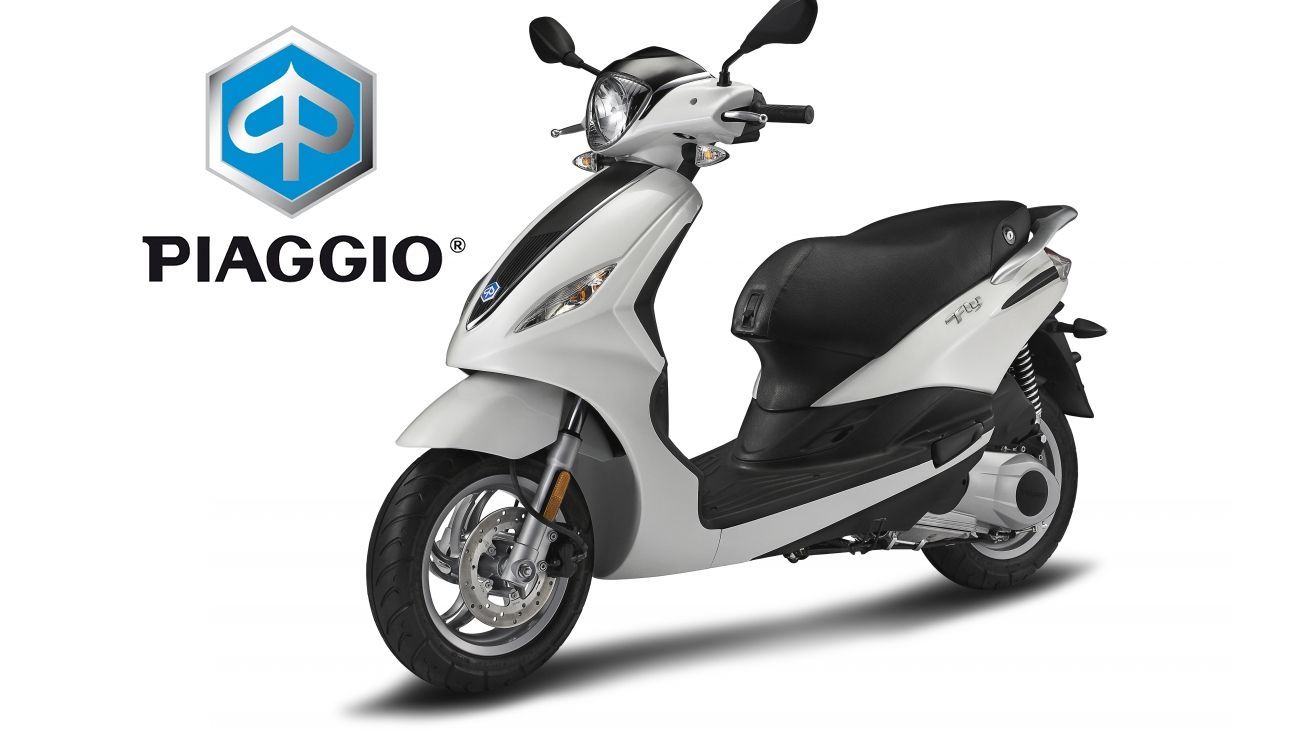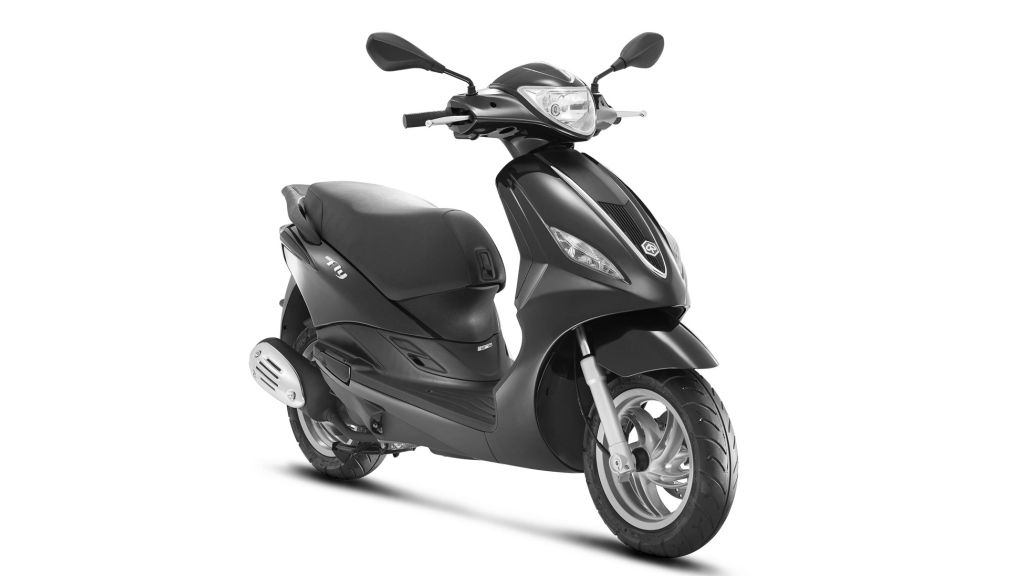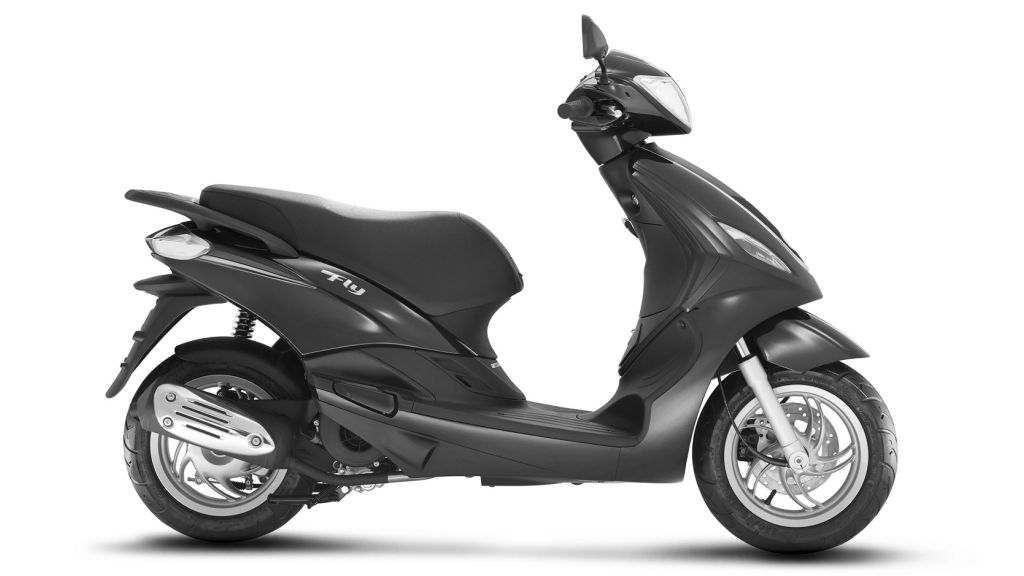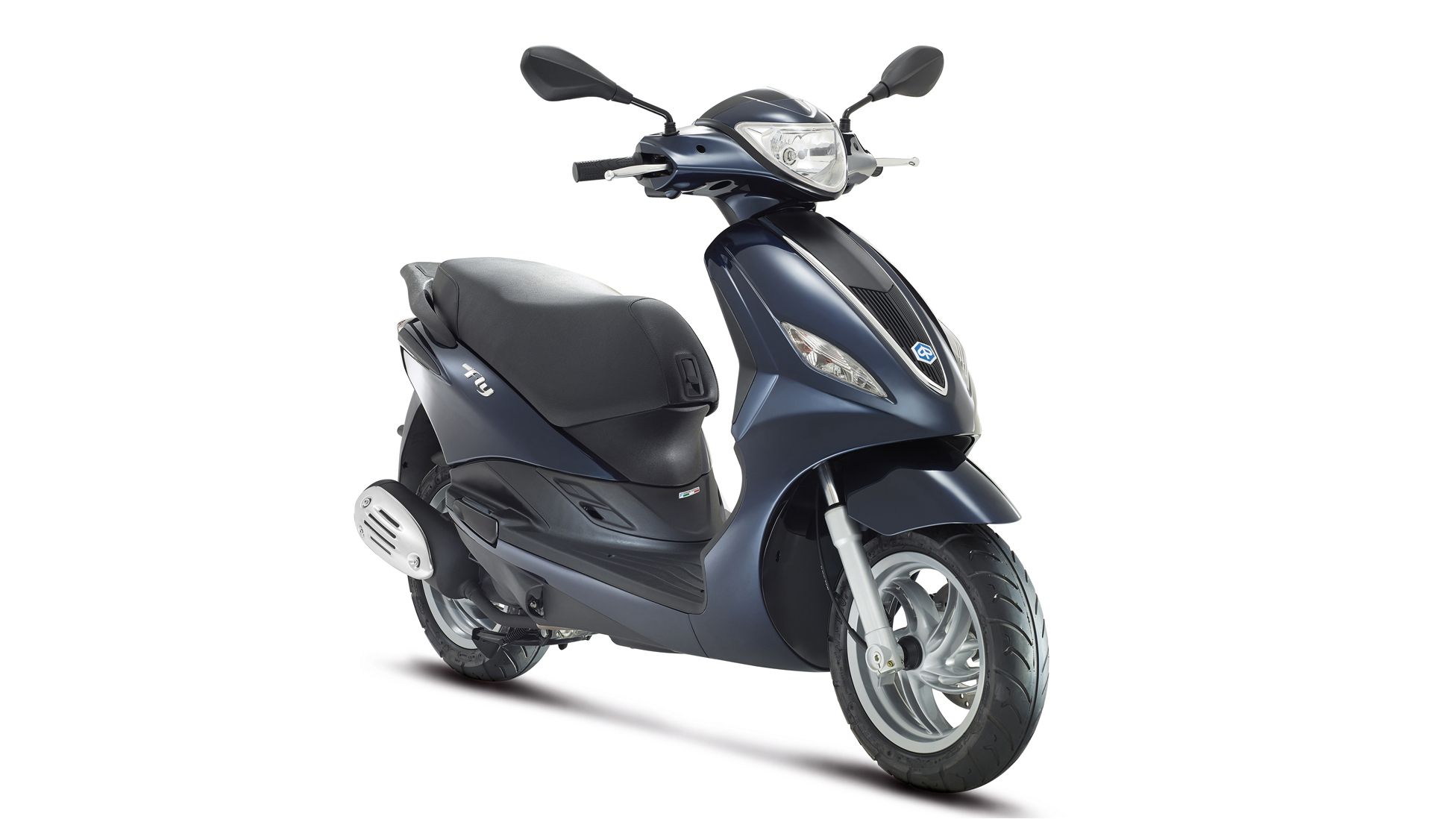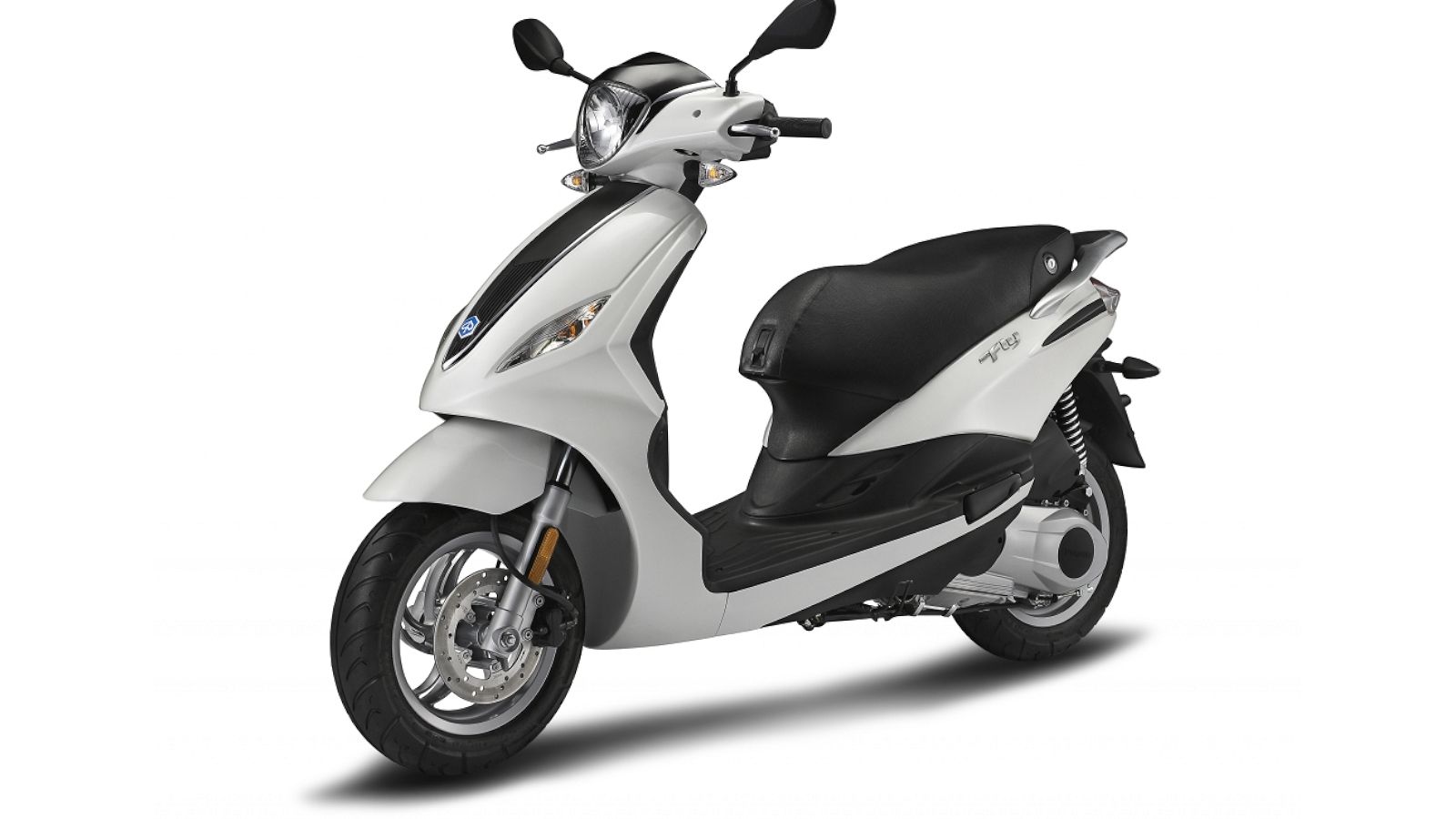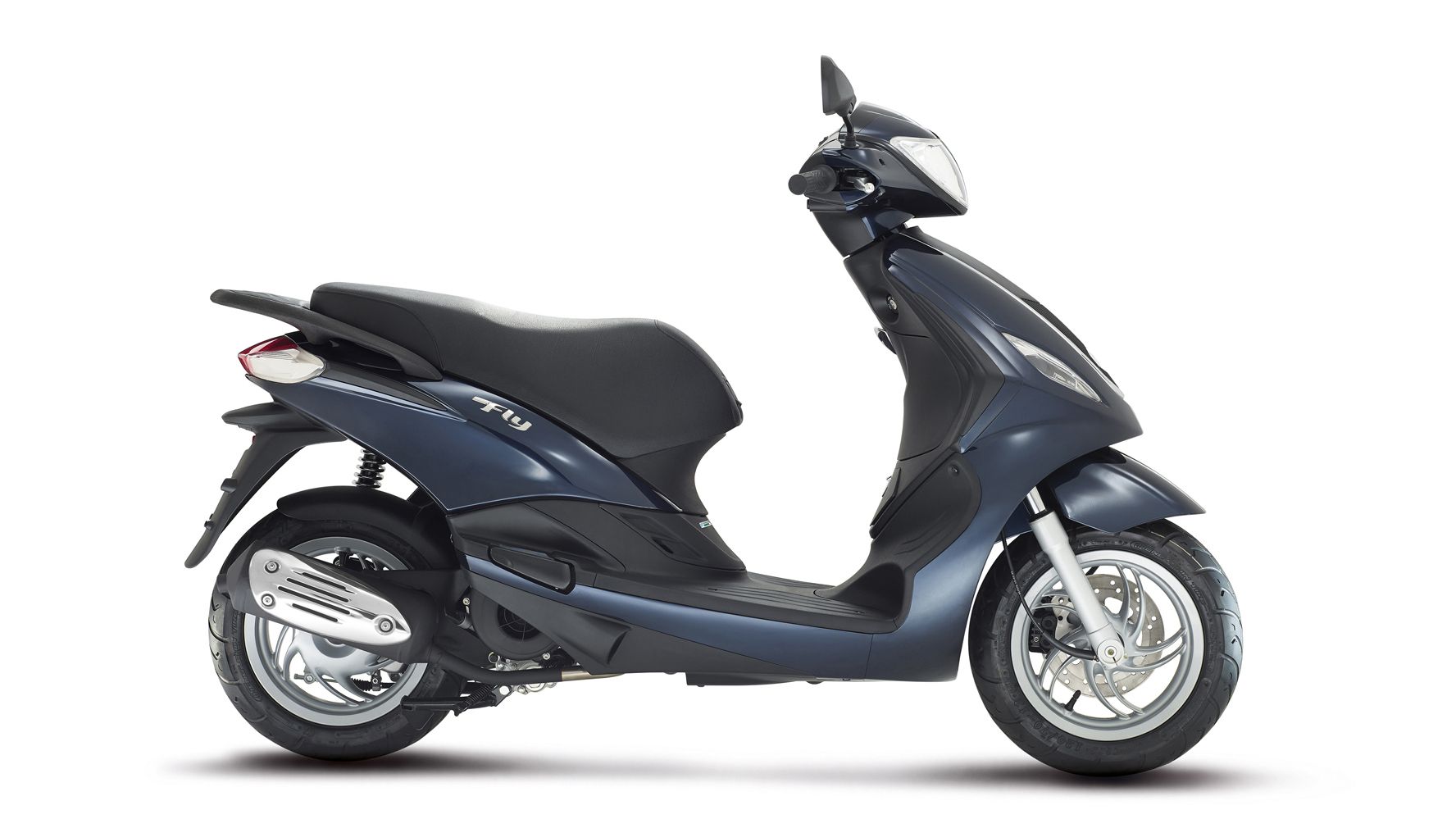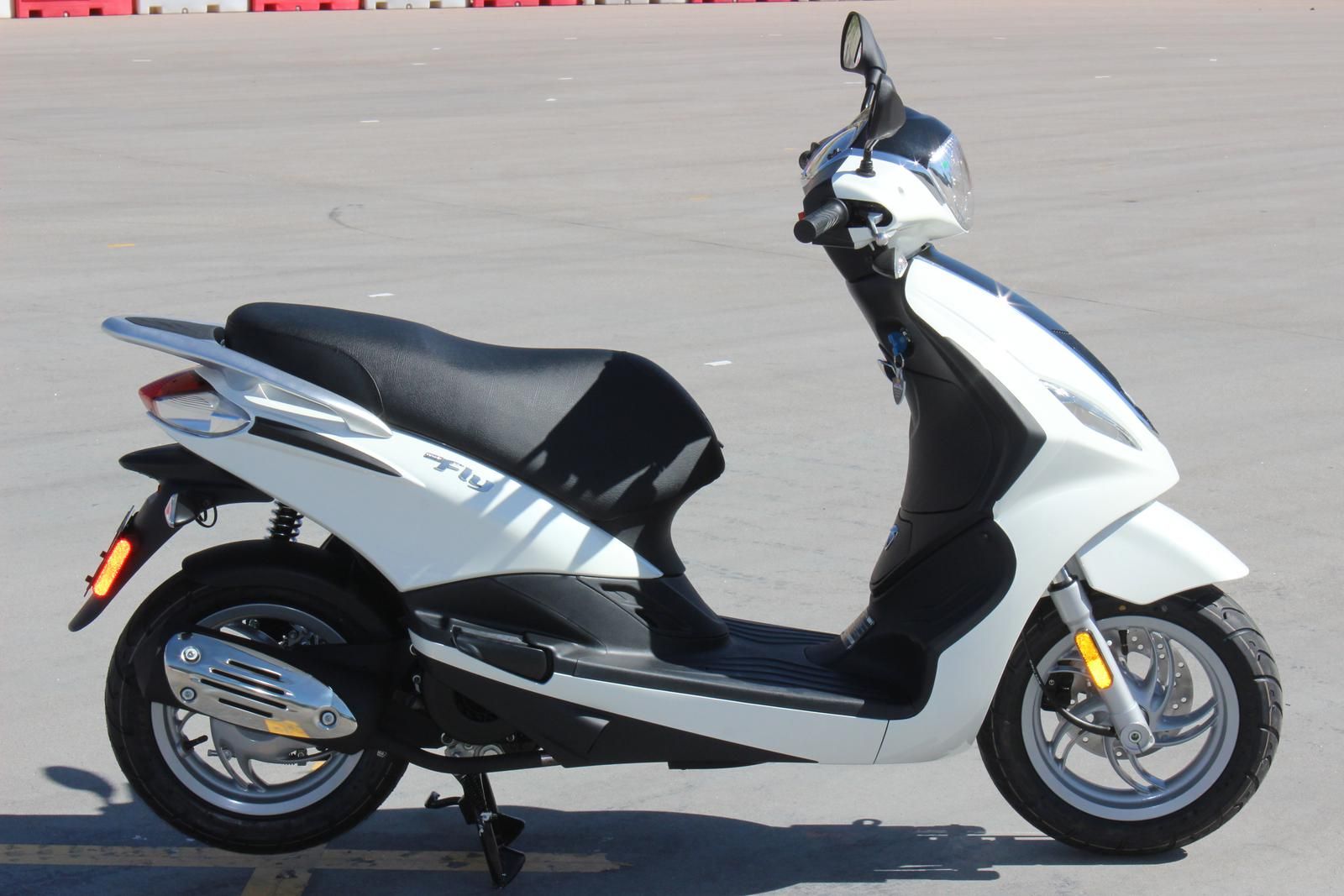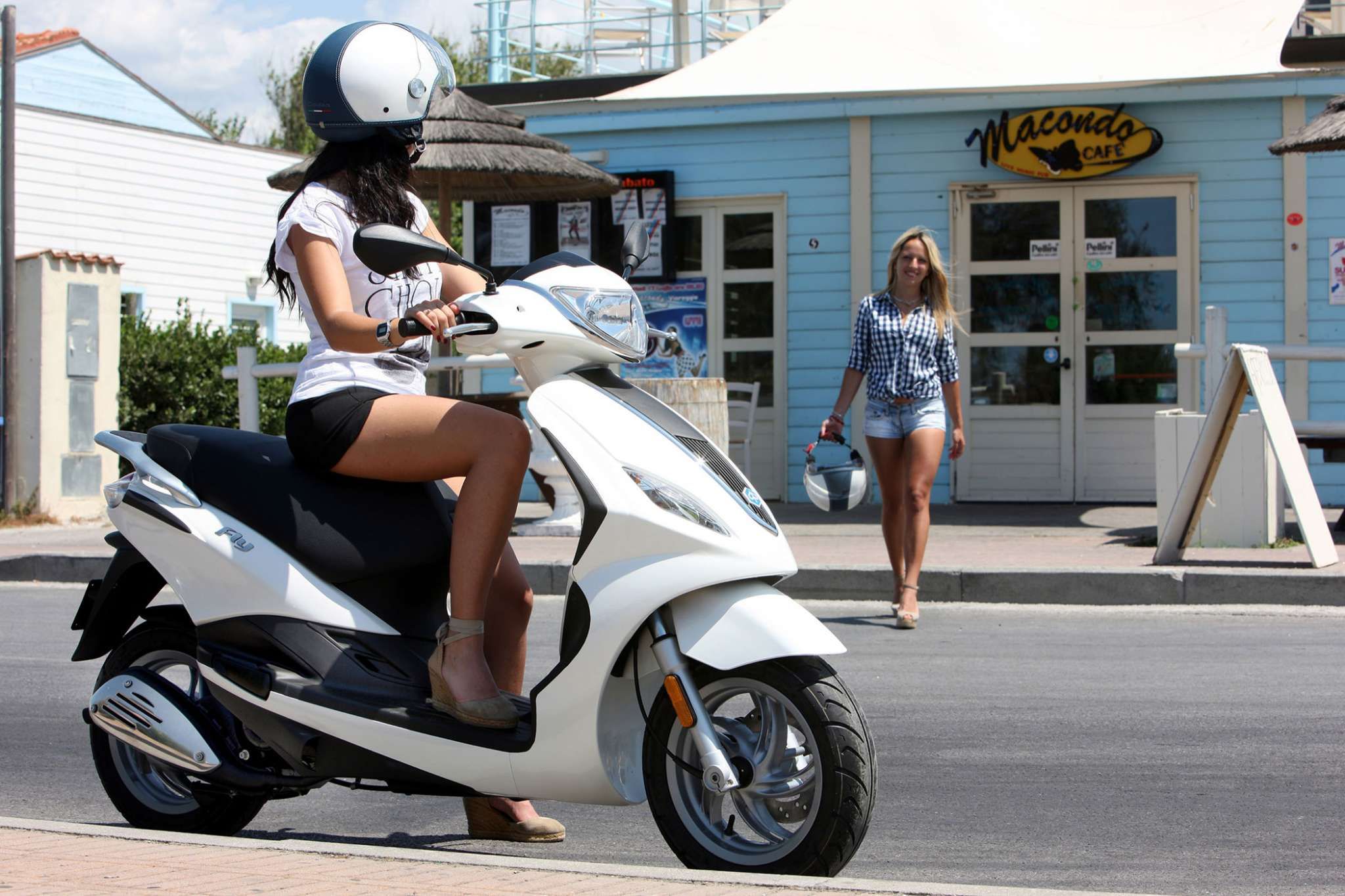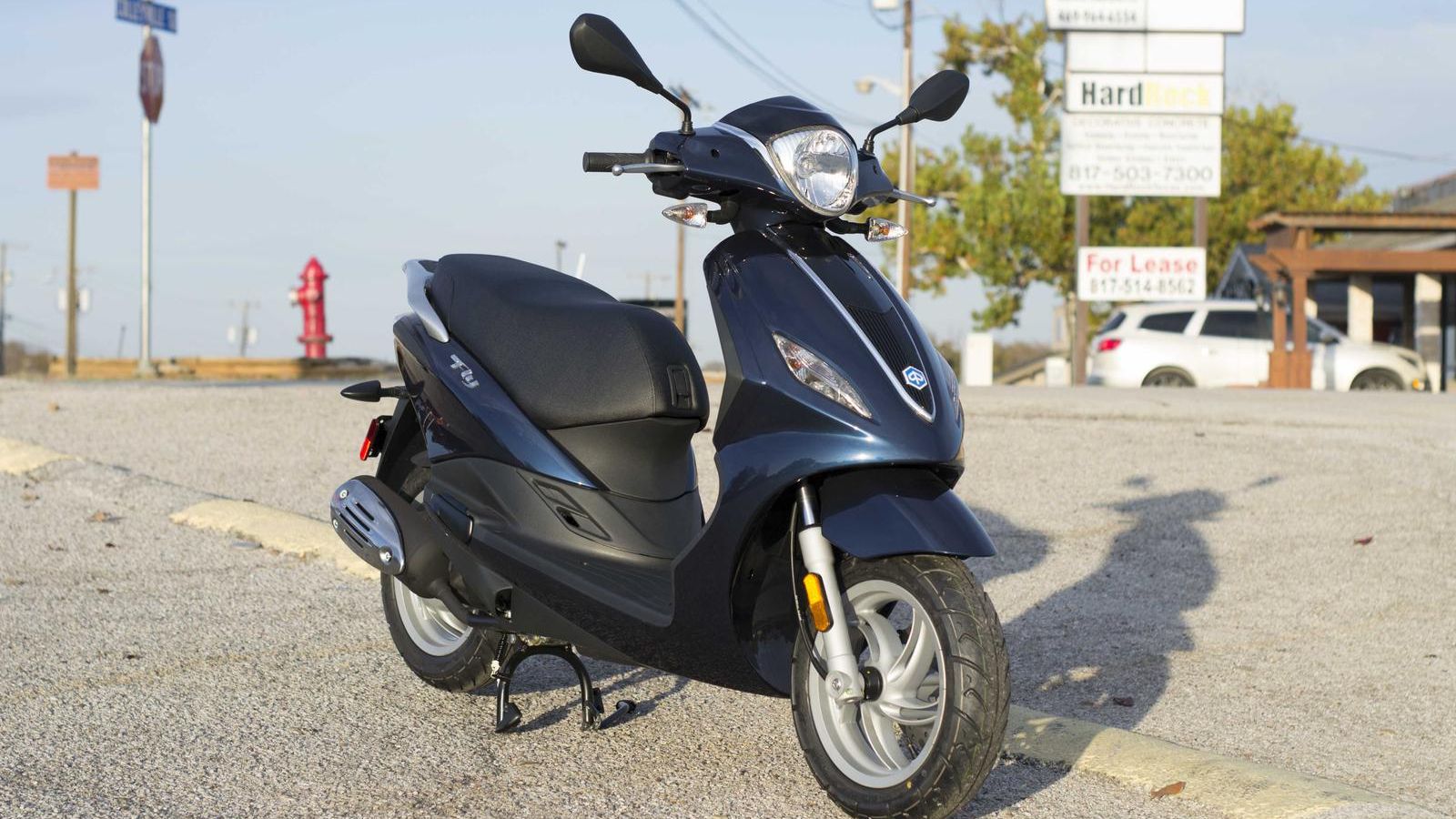On the campus, in the gated community or in an urban area, it's hard to go wrong with a small-displacement scooter for running errands or generally getting around. Piaggio is happy to accommodate you with its Fly duo. On 12-inch wheels with all the usual storage a scooter can boast, the Fly 50 and Fly 150 carry a petite 1.8-ish gallon fuel tank; but with 100+ mpg in fuel economy, that little tank takes you far.
Continue reading for my review of the Piaggio Fly 50 and Fly 150.
2014 - 2018 Piaggio Fly 50 / Fly 150
- Make: Array
- Model: 2014 - 2018 Piaggio Fly 50 / Fly 150
- Engine/Motor: Single-cylinder, four-stroke Piaggio LEADER
- [do not use] Vehicle Model: Array
Design
In the metro-mobility sector, Piaggio has you covered. At just a skosh under 30 inches, the Fly 50 and Fly 150 has the lowest seat height in the Piaggio lineup and at 220 pounds and 247 pounds, respectively, they are also the lightest in their classes. Lightweight and a low center of gravity makes them easy to handle. Tubeless tires means riding stability.
A trip to the accessories catalog sets you up to personalize your Fly with a windscreen, top case for additional storage, security accessories and a weatherproof rear view mirror/smart phone bracket. Really, the only question is which one? The 50 or the 150 cc engine? The 50 cc engine tops out at about 40 mph whereas the 150 cc model has a top speed of about 61 mph -- depending, of course, on total rider/passenger/cargo weight and road condition. If city streets amid urban congestion is your usual environment, go 50 cc. If you speed any time on streets and roads with speed limits over 30 mph, go 150 cc. Either way, you have a ride that is easy to handle and easy to park.
Chassis
Piaggio, and its subsidiary Vespa, are well acquainted with monocoque, stressed-skin scooter designs, but instead went with a proper underframe made from tubular steel stock. Not only does this method allow for easier replacement of damaged body panels, but it allows for a flat deck in the step-through and that extra little bit of between-feet storage space.
The factory also keeps it conventional at the front end with a pair of 32 mm, telescopic wet forks instead of its fancy, single-side front end with cantilever suspension, and I am OK with that. A hydraulic monoshock springs the rear end off the swing-mount motor unit to complete the suspension.
Cast-aluminum rims mount 120/70-12 hoops front and rear. The front brake consists of a 220 mm disc with a floating, twin-pot caliper, but the rear brake cleaves to tradition with a 140 mm, mechanical drum -- not my favorite to be sure, but certainly sufficient for the 220-pound Fly 50, and 247-pound Fly 150 dry weight.
|
Chassis: |
Tube type |
|
Front Suspension: |
Telescopic hydraulic forks, 32 mm |
|
Rear Suspension: |
Hydraulic single shock absorber, 73 mm |
|
Front Brake: |
Disc 220 mm |
|
Rear Brake: |
Drum 140 mm |
|
Front Tire: |
120/70, 12" |
|
Rear Tire: |
120/70, 12" |
Drivetrain
The Fly 50 runs Piaggio's HI-PER4, four-stroke thumper for propulsion. Ever-so-slightly undersquare, the 38.1 mm bore and 40.6 mm stroke, plus combustion-chamber volume, give the engine an overall displacement of 49.9 cc. A SOHC times the four-valve heads, and forced-air cooling carries waste heat away from rider and passenger. This little mill churns out 2.8 pound-feet at 8,000 rpm and 4.6 horsepower at 9,5000 rpm for a top speed of 39 mph at 104 mpg.
A bit higher on the food chain is the Fly 150 with its 155 cc, four-stroke LEADER mill. Bore and stroke measure out at 57.9 mm and 58.4 mm respectively for a slightly undersquare layout similar to its smaller cousin. A three-valve head gets actuated by the SOHC, and this larger engine boosts power output up to 12 ponies with 9.6 pounds of grunt and a top speed of 61 mph.
Both couple engine power to the rear wheel through a dry centrifugal clutch and continuously variable transmission for easy, “Twist 'n go” operation. Engine, transmission and swingarm come married together as a unit, a typical arrangement for scooters, and one that reduces sprung weight but at the cost of more unsprung weight on the rear axle.
|
Model: |
Fly 50 |
Fly 150 |
|
Engine: |
Single-cylinder, four-stroke Piaggio HI-PER4 |
Single-cylinder, four-stroke Piaggio LEADER |
|
Distribution: |
Single overhead camshaft SOHC with four valves |
Single overhead camshaft SOHC with three valves |
|
Displacement: |
49.9 cc |
155 cc |
|
Bore x Stroke: |
1.5" x 1.6" |
2.28" x 2.3" |
|
Max Power @ Shaft: |
4.6 hp (3.4 kW) @ 9,500 rpm |
12 hp (9 kW) @ 7,000 rpm |
|
Max Torque: |
2.8 lb-ft (3.8 Nm) @ 8,000 rpm |
9.6 lb-ft (13 Nm) @ 6,000 rpm |
|
Max speed: |
39 mph |
61 mph |
|
Cooling System: |
Forced air |
Forced air |
|
Lubrication: |
Wet sump |
Wet sump |
|
Ignition: |
Electronic |
Electronic |
|
Transmission: |
CVT automatic ratio variator ('Twist 'n go') |
CVT automatic ratio variator ('Twist 'n go') |
|
Clutch: |
Dry automatic centrifugal type |
Dry automatic centrifugal type |
Pricing
MSRP on the Fly 50 is $2,299 and the Fly 150 is $600 more. Both models come in basic White or Graphite Black, and the 150 also comes in Midnight Blue. Piaggio offers a two-year unlimited-mileage warranty and adds to that one year of road side assistance provided by Road America.
|
Model: |
Fly 50 |
Fly 150 |
|
Fly 50 |
Graphite Black, White |
Graphite Black, White, Midnight Blue |
|
Fly 150 |
$2,299 |
$2,899 |
Competitors
Piaggio is definitely one of the big players in the scooter world with a number of subsidiaries under its umbrella, so I decided to give one of the little guys some play here and settled on the CF-50 from Wolf Brand Scooters. Both rides have a pointy front section and sleek, post-modern look, but Wolf ramps up the pressure with carbon-fiber body panels left “naked” so they become part of the overall charm. However, the painted “sheet metal” on the Fly 50 seems to accentuate the elegant form somewhat, and to be honest, I kind of like the way both of them look, just for different reasons. I also like the full-depth step-through and flat deck that facilitates easy mounting/dismounting and groceries between the feet.
Engine size is very comparable with a 49.6 cc mill on the CF-50 that surrenders a mere 0.3 cc to the Fly, but mileage falls off with the Wolf at only around 90 mpg versus 104 mpg with the Piaggio product. Wolf is a little ambiguous with its top speed, and states on that it will do 30-plus mph while Piaggio claims a solid 39 mph, and both run the ubiquitous, swing-mount motor unit. These two also share the same sort of suspension layout with hydraulic front forks and a coil-over monoshock, and they both sport a disc brake up front and mechanical drum in back.
Wolf picks up a win with a significant price difference in its favor. At a mere $1,299, the Wolf CF-50 is a full grand cheaper than the $2,299 Piaggio Fly 50. That represents a chunk of change that may well drive folks toward the lesser-known Wolf product, and even though fit and finish seems to be decent enough on the CF-50, Piaggio's experience still shows in this area and comes off looking like a somewhat superior product.
He Said
My husband and fellow motorcycle writer, TJ Hinton, says, "Meh, looks like just another futuristic scooter to me. I'm not a scooter rider, but I do know what looks cool and what doesn't, and these modern-looking scoots just don't do it for me. If I had to ride a small scooter like this, I would certainly pick something with some retro charm that carries the classic look of the '60s atop modern equipment."
She Said
"I know my husband has no use for scooters, and I know he would probably walk instead of riding one no matter how cool it looks. I think they are great for urban mobility and after spending a lot of time on a sprawling college campus, I really appreciate inexpensive, easy-to-park, fuel economical transportation. If I were looking at the Fly, though, I'd have to also consider the Typhoon. It has a little bigger fuel tank, bigger wheels and it comes in just a little less expensive than the Fly."
Specifications
|
Model: |
Fly 50 |
Fly 150 |
|
Fly 50 |
||
|
Engine: |
Single-cylinder, four-stroke Piaggio HI-PER4 |
Single-cylinder, four-stroke Piaggio LEADER |
|
Distribution: |
Single overhead camshaft SOHC with four valves |
Single overhead camshaft SOHC with three valves |
|
Displacement: |
49.9 cc |
155 cc |
|
Bore x Stroke: |
1.5" x 1.6" |
2.28" x 2.3" |
|
Max Power @ Shaft: |
4.6 hp (3.4 kW) @ 9,500 rpm |
12 hp (9 kW) @ 7,000 rpm |
|
Max Torque: |
2.8 lb-ft (3.8 Nm) @ 8,000 rpm |
9.6 lb-ft (13 Nm) @ 6,000 rpm |
|
Max speed: |
39 mph |
61 mph |
|
Cooling System: |
Forced air |
Forced air |
|
Lubrication: |
Wet sump |
Wet sump |
|
Ignition: |
Electronic |
Electronic |
|
Transmission: |
CVT automatic ratio variator ('Twist 'n go') |
CVT automatic ratio variator ('Twist 'n go') |
|
Clutch: |
Dry automatic centrifugal type |
Dry automatic centrifugal type |
|
Chassis: |
||
|
Chassis: |
Tube type |
Tube type |
|
Front Suspension: |
Telescopic hydraulic forks, 32 mm |
Telescopic hydraulic forks, 32 mm |
|
Rear Suspension: |
Hydraulic single shock absorber, 73 mm |
Hydraulic single shock absorber, 73 mm |
|
Front Brake: |
Disc 220 mm |
Disc 220 mm |
|
Rear Brake: |
Drum 140 mm |
Drum 140 mm |
|
Front Tire: |
120/70, 12" |
120/70, 12" |
|
Rear Tire: |
120/70, 12" |
120/70, 12" |
|
Fly 150 |
||
|
Length: |
72.8" |
72.8" |
|
Width: |
27.7" |
27.7" |
|
Wheelbase: |
52.2" |
52.2" |
|
Seat Height: |
29.9" |
29.9" |
|
Dry Weight: |
258 lbs (117 kg) |
247 lbs |
|
Fuel tank capacity: |
1.8 gal |
1.8 gal |
|
Gas mileage: |
104 mpg |
104 mpg |
|
Engine & Drivetrain: |
||
|
Type Approval: |
EPA and CARB |
EPA and CARB |
|
ABS: |
No |
No |
|
Colors: |
Graphite Black, White |
Graphite Black, White, Midnight Blue |
|
MSRP: |
$2,299 |
$2,899 |
References
See our review of the Piaggio Typhoon.


